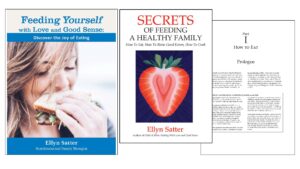

Family Meals Focus
The Ellyn Satter Institute Newsletter
Perimenopause and the Satter Eating Competence Model
by Amy Ozier, PhD, RD, LDN
Click here for a PDF of this newsletter
Perimenopause means “around menopause.” It is the time leading up to your last period. As I ponder the direction this article will go, I must share that I recently turned 50. Although the exact age perimenopause hit is fuzzy, I am quite sure I was 44. Whether you have entered “the change” or are wondering if you have, I have such compassion for you. If you do not have peace with food and your body, I add on an extra heap of compassion. I have been there. I was diagnosed with anorexia at the tender age of seven and my struggles with eating followed me for decades. However, thanks to Eating Competence, nervous system regulation, and spiritual awakening, I can proclaim freedom from an unhealthy relationship with food and share that with clients. I am incredibly grateful to be at a place of clarity with “the change” and my body. I am also grateful for the perimenopausal process of change: For me, it was a time of looking back, pausing at the present, and looking ahead. Surprisingly, it has been a time of opening up rather than of closing down.
I now utterly understand the power of hormones. Along with changes in my menstrual cycle, my traditional symptomology included brain fog, hot flashes, irritability, headaches, extreme fatigue, heart palpitations, and body size and shape changes. My atypical symptoms, the ones that didn’t show up on web searches, included chest pain, musculoskeletal pain and discomfort, odd smells coming from the crevices of my body, mouth sores, shakes, fluid filled cysts on my breasts that would enlarge with variations in my cycle, iron deficiency anemia, and muscle spasms. The same as other perimenopausal women, I was at increased risk for cardiovascular disease, osteoporosis, sleep disturbances, and anxiety and mood disorders. I learned that baseline labs should include a lipid panel, comprehensive metabolic profile, vitamin B12, menopausal panel, and any other screenings recommended for this middle age group.
How Eating Competence Blesses “The Change”
Perimenopausal symptoms can make it more difficult and confusing than ever before to trust your body. Being Eating Competent makes all the difference. If this concept is new to you, snuggle in and get ready for a life-changing experience. Eating Competence (EC), as defined by the Satter Eating Competence Model (ecSatter), is being positive, comfortable, and flexible with eating as well as matter-of-fact and reliable about eating as much as you want of food you personally enjoy.1 How does this definition make you feel? Does eating as much as you want of food you enjoy feel foreign? Dangerous? Does it make you think of certain clients? Of yourself?
People with high EC are more trusting and comfortable, both with themselves and with other people.2 That certainly has been the case for me: EC serves as a constant, even with my body size and shape changes. I am confident that, regardless of my size and shape, I get to eat—that is how God made me. I trust my body to eat and eat enough. I didn’t always feel this way. I now suspect my early difficulty eating as much as I needed grew out of family struggles and particularly uncomfortable mealtimes. My early troubles with eating were compounded by our food and fat phobic society. Becoming an RD didn’t help. Becoming a university professor of nutrition didn’t help. I was in my 30s when I read Satter’s Normal Eating definition and felt like the angels had come out to sing. It begins like this: Normal eating is going to the table hungry and eating until you are satisfied. . . It is being able to choose food you enjoy and to eat it and truly get enough of it—not just stop eating because you think you should. . . . You can read the rest of it here. I know now that the self-trusting normal eating description is about the eating attitudes, contextual skills, internal regulation skills, and food acceptance skills that make up Eating Competence.
As I learned about EC, I fed myself faithfully, gave myself permission to eat, and one day, I experienced my stopping place. It was like being reborn! Now I celebrate eating and in my clinical practice I work with clients who struggle with a variety of eating disorders and disordered eating and help them do the same. How did I get right with weight and the body size and shape God designed me to have? I poignantly remember Ellyn Satter pointing out that eating and weight are often presented as being one and the same, but in reality they need to be considered separately. We get to eat and can become EC regardless of our weight. With respect to weight, I had to do some radical acceptance and come to terms with the fact that weight gain is a normal part of aging. Along with the fact I was exhausted with 3 kids, managing hormones and all the life things, perimenopause brought me to the bottom line. It did not make sense anymore to make weight my identity: I had much more important things in life to tend to.
Setting aside my weight concerns allowed me to become EC, and being EC came with its own rewards. Food is such a comfort, and being EC lets me return to my love of food and of nutrition science! I delighted in comfortably satisfying my cravings for delicious high-fat, high-sugar food, treated my iron-deficiency anemia with a big steak when I went out to eat with my hubby, and ate cruciferous vegetables prepared in ways I enjoyed, meanwhile getting indoles that aid in lymphatic system disturbances. I model EC for my family of five including three teens and depend on EC contextual skills to help feed them. I use EC internal regulation as a witness to clients when I matter-of-factly eat with them during the focused eating exercises I learned in the Treating the Dieting Casualty workshop,3 even in back-to-back sessions. Before I became EC, I would have worried, “Am I eating too much?”
What women bring to perimenopause
The same as I did, many women arrive at perimenopause in trouble with their eating. By the time the change starts, they have chronically attempted to diet, change their bodies, lose weight, eat “right,” and overexercise. The change presents a vulnerable time when negative body image and eating disorders can ensue or resurface.4 Many women have experienced trauma and use food and efforts to change their body as their lifelong maladaptive form of coping. Food has become a threat as well as a panacea accompanied by guilt and shame. From the perspective of Polyvagal theory,5 the autonomic nervous system comes into play by activating nervous system responses. Add in pre-existing nervous system dysregulation and the overall impact of perimenopause on body size and shape and it is little wonder that you have a barrage of body dissatisfaction: Perimenopausal women blame themselves for being “overweight.”
Women see the menopausal transition as a loss: a loss of youth, of the childbearing years, of being vital and productive. It need not be so. Judith Viorst, in Necessary Losses, says to reap the benefits of the next stage of life, one must address the grief and loss associated with giving up the rewards of the previous stage. Those rewards are not always positive and, in fact, may be emotional strongholds: maladaptive coping mechanisms used “to survive.” However negative, many women today use conflict, anxiety, and repeated failed efforts to control food and their bodies to distract them and give them short term, superficial relief from what is really bothering them. As my perimenopausal clients struggle to identify those maladaptive rewards, we wonder, “what is this doing for you?” For many, answering that question is a light bulb—and freeing—moment.
What women can take from menopause
Erickson’s Psychological Stages identifies Middle Age as a crisis of generativity vs. self-absorption: standing on the threshold of choosing, however unconsciously, one or the other. Concern for family and society in general is a favorable outcome of this crisis. Concern only for the self, one’s own well-being and prosperity, is an unfavorable outcome. Generativity is the desire and ability to guide the next generation.6 Being stuck in preoccupation with one’s food and body makes generativity impossible. Developing EC is a way of setting aside self-preoccupation, being freed to be a nurturer and role model for family, friends, and the community. For many, becoming EC offers an opportunity to break the multigenerational spell of distorted eating attitudes and behaviors and leave a legacy for generations to come of a heathy relationship with food.
Many women at this stage need help becoming EC. When the client is ready, we explore “then and now.”
- Then: Going many hours or days without eating,
Now: Feeding themselves faithfully with reliable and enjoyable meals and snacks - Then: Trying to eat only so much.
Now: Giving themselves permission to eat. - Then: Trying and failing at a vast array of restrictive diets.
Now: Become Eating Competent. - Then: Blaming all body ailments on food and/or weight.
Now: Identify medical/physiological underpinnings and address directly. - Then: Trying to address depression and anxiety with diet.
Now: Identify emotional and nervous system underpinnings and address directly. - Then: Shame about weight gain, body size and shape changes.
Now: Put weight “in a box” and concentrate on other changes.
Treating the Dieting Casualty VISION Workshop
Ellyn Satter’s Treating the Dieting Casualty VISION Workshop was a professional starting point for me and life-changing for me and my clients. Although I took the TDC workshop with professional intent, it was also a blessing for my personal journey. As I sit with my TDC binder in hand and reflect on what I learned, the highlights were “Eating Competence: Putting it All together7,” “Identifying the Dieting Casualty,” “Assessment Tools,” and “How to Eat Sequence of Change.” Additionally, the manual gave me a plethora of handouts that operationalized Eating Competence treatment. Titles of these How to Eat handouts include “What makes a good meal,” “How to help your body regulate.” and “Learning How to Eat with Type 2 Diabetes,” and many more. The CEU’s were a bonus as well.
The take-home message
Perimenopause presents a very real struggle for clients, especially those who have experienced lifelong conflict and anxiety about eating. It also presents a time of deep reflection about how one wants the rest of their life to roll. What if misery about eating and weight could be set aside? What if, instead, eating and living in one’s body could be a joyful landing spot in this time of trial? The Satter Eating Competence Model provides a road map. As Ellyn Satter states “When the joy goes out of eating, nutrition suffers.”8 May we as practitioners help bring joy back to eating and life during perimenopause for our clients . . . and ourselves!
References
- Satter E. The Satter Feeding Dynamics Model of child overweight definition, prevention and intervention. In: O’Donahue W,Moore BA, Scott B, eds. Pediatric and Adolescent Obesity Treatment: A Comprehensive Handbook. Taylor and Francis; 2007:287-314.
- Krall JS, Lohse B. Validation of a measure of the Satter Eating Competence model with low-income females. Int J Behav NutrPhys Act. 2011;8. doi:10.1186/1479-5868-8-26 PMC3094263,
- Satter E. Treating the Dieting Casualty VISION Workshop: Intensive training on treating chronic dieting and eating disorders.Ellyn Satter Institute. 2024. https://www.ellynsatterinstitute.org/education/workshops-keynotes/treating-the-dieting-casualty-vision-workshop/
- Mangweth-Matzek B, Hoek HW, Rupp CI, et al. The menopausal transition–a possible window of vulnerability for eatingpathology. Int J Eat Disord. Sep 2013;46(6):609-16.
- Porges SW. The polyvagal theory: new insights into adaptive reactions of the autonomic nervous system. Cleve Clin J Med.Apr 2009;76 Suppl 2(Suppl 2):S86-90.
- Erikson EH. Eight Ages of Man. Childhood and Society, 2nd Edition. W.W.Norton; 1993:242-274.
- Satter E. Family Meals Focus #26: Eating Competence: Putting it all together. https://www.ellynsatterinstitute.org/family-meals-focus/26-eating-competence-putting-it-together/
- Satter E. Secrets of Feeding a Healthy Family: How to Eat, How to Raise Good Eaters, How to Cook. Kelcy Press; 2008.
Understand and Apply ecSatter
ecSatter self-help materials

